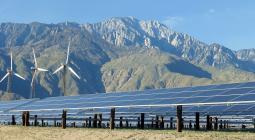Misguided Affordable Clean Energy rule is on the wrong side of history.

The Trump administration’s misguided new Affordable Clean Energy rule is on the wrong side of history and the law. In its seeming obsession to reverse the EPA's previous Clean Power Plan, the Trump EPA is failing in its singular mission: to protect public health and welfare from the adverse impacts of too much carbon pollution.
This abdication of duty includes failing to address causes of the heavy flooding and intense heat in the Midwest, stronger storms and more wildfires across the nation, and more extreme weather events globally. Solving our climate change problems is the moral, economic, policy, political and technological challenge of our generation. The Trump EPA’s new “ACE” rule fails the American people.
The Midwest still produces more electricity from coal plants than any other region of the country, and Midwesterners bear the full range of pollution harms to public health, the Great Lakes, and overall environmental quality. The Clean Power Plan established flexible and predictable standards to reduce carbon pollution from coal and natural gas plants and to accelerate renewable energy growth and energy efficiency improvements. Instead of driving our nation forward to seize modern clean energy technologies and global leadership, however, the so-called Affordable Clean Energy rule reverses course, moves our nation backward and misses opportunities. It’s a misguided plan for at least three principal reasons:
First, the ACE rule will allow more pollution causing climate change problems. The Clean Power Plan set a reasonable goal of reducing carbon pollution from the power sector by 32 percent overall by 2030. States had clear standards and flexible tools to reduce or offset carbon pollution and the energy industry had a predictable set of standards for making investment decisions. EPA’s own analysis shows that its ACE rule would result in more pollution, which is estimated to cause 1,630 more early deaths per year in 2030 compared to implementing the Clean Power Plan.
Second, the ACE rule constrains economic growth and costs jobs. Cost-benefit analyses consistently showed that the Clean Power Plan would result in a net gain for the economy. Replacing it with the do-little or do-nothing ACE rule won’t save the economically uncompetitive coal industry. Renewable energy is cheaper than coal, and Midwestern utilities, such as Consumers Energy and NIPSCO, are shifting theirinvestments to help consumers benefit from modern solar energy and wind power technologies. By contrast, coal plant pollution imposes higher health care and environmental remediation costs on consumers beyond our utility bills.
Renewable energy jobs are booming across America and greatly exceed coal plant and mining jobs in most states. The coal to clean energy transition creates stable, new job opportunities for both high-tech solar and wind equipment technicians and new high-wage employment opportunities for blue-collar construction workers. The Trump administration’s ACE plan would move our nation backward, hurt our pocketbooks and cost America jobs.
Third, the ACE rule is legally flawed and contrary to EPA’s mission. The Clean Air Act requires EPA to adopt the “best system of emissions reduction” to reduce air pollution, including carbon emissions. The ACE rule does not meet that goal, it substantially weakens prior requirements for CO2 pollution reductions, and it does not include pollution reduction standards at all for existing natural gas plants. In short, the ACE rule abandons EPA’s responsibility to take effective actions to reduce carbon pollution from power plants even though scientific evidence demonstrates that CO2 pollution endangers public health.
The ACE rule actually is not “affordable,” because the costs of climate change are high and getting higher. Keeping large parts of the U.S. energy economy unduly chained to more costly coal plants means that our nation will fall behind the world’s growing green economy instead of leading with innovation. Allowing more old coal plants to keep polluting our air and water means people will pay more through higher healthcare costs and insurance rates. The Great Lakes region is already heating up quickly according to a recent report by 18 leading Midwestern and Canadian scientists focused on the local impacts of climate change.
The Midwest is making great strides in shifting to renewable energy generation from solar energy and energy storage, along with wind power. The renewable energy supply chain businesses are rapidly growing. America’s Heartland is well positioned to lead us forward in delivering climate change solutions powered by renewable energy and energy efficiency improvements. This energy sector transition is good for Midwest jobs, good for clean air and water, and good for economic growth.
The new ACE Rule is misguided policy, moves our nation backward in solving climate change problems, and misses opportunities for economic growth and innovation in the global shift to renewable energy. If not reversed by the courts, as it should be, the next administration will have the challenge of doing the right thing for public health, the climate and our clean energy future.
Howard A. Learner is the executive director of the Environmental Law & Policy Center of the Midwest. ELPC is the leading Midwest public interest environmental legal advocacy organization, and among the nation’s leaders, working to improve environmental quality, protect public health, and protect natural resources in ways that grow the regional economy. Follow him on Twitter at @HowardELPC.
20 June 2019
THE HILL


